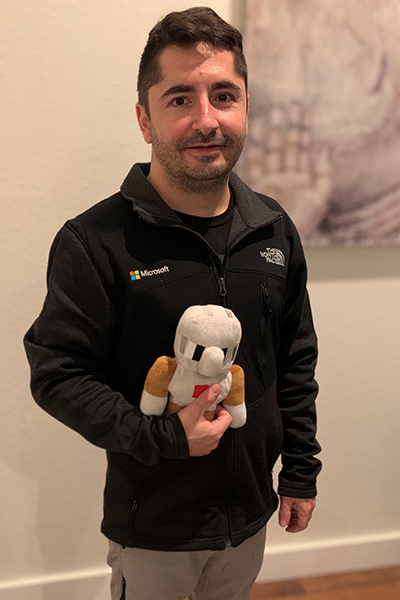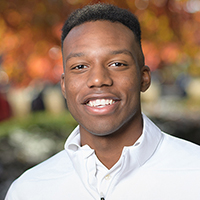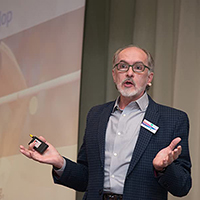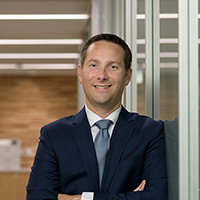Beyond the Data
Alumnus remains on the leading edge of business analytics
 Francisco Rius (BSM ’04, MBA ’07), head of data science for Microsoft’s Minecraft franchise, has already traveled many miles in his burgeoning career.
Francisco Rius (BSM ’04, MBA ’07), head of data science for Microsoft’s Minecraft franchise, has already traveled many miles in his burgeoning career.
The journey began in his hometown of Mexico City, Mexico, where as a teenager he began building software and selling it online. As the time approached to make a college decision, Rius took a roundabout route to discover Purdue.
“I was looking for programs that were heavy on IT and would help me build management and business skills,” he says. “I didn’t really know anyone in the United States except for a cousin who was a PhD student in mathematics at Purdue, and she recommended that I look into the program at Krannert. I visited, fell in love with the campus and ultimately enrolled.”
Rius’ view of the world quickly blossomed. “Interacting with people from multiple countries and nationalities as an undergrad was very eye-opening to me,” he says. “I also learned an important lesson about time management from an accounting professor who taught us about diminishing returns. I realized that if I spent three or four hours on a project, it probably would be as valuable as spending eight or nine hours. You get to the point where you just can't solve every little detail around a problem.”
He also gained the skills to enter the workforce and be successful in his first job at Passageways, a software development startup initially funded with an award from the Burton D. Morgan Business Model Competition. Now in its 17th year of operations, the company is led by Krannert alumnus Paroon Chadha and serves more than 2,000 customers through offices in Lafayette, London and Toronto.
Following a successful year as Passageways’ business development manager, Rius opted to return to Krannert to earn an MBA. “Paroon was my first boss and I think I was his first employee,” he says. “We’ve remained good friends and I’ll always be grateful for the opportunity he gave me.”
“Grad school was really about understanding big picture strategy,” Rius says. “We talked about what big companies were doing. We applied case studies to real-world examples. We also networked very strongly. A lot of my classmates are very successful and we keep each other up to speed around career trajectory.”
Analyzing Opportunities
Another key success point in Rius’ MBA studies came with a summer internship at Dish Network, an opportunity he found by taking his own path.
“A lot of students print out 50 resumes, go to career fairs and play a game of volume to land that first internship or job,” Rius says. “My search was targeted. At the time, I was watching a lot of soccer on TV and I was a customer of Dish Network. “
“That was the one internship I was interested in pursuing, so I went to them directly, talked to them about their product, and ended up spending a summer with the company in Denver. Afterward, they made me a full-time offer to go back to work with them after grad school.”
Rius spent about five years at Dish, where his role eventually moved toward data analytics. “I was doing a lot of the statistics, segmentation, and targeting for the customer retention efforts,” he says. “It sounds small, but in the context of a big company with 14 million customers, if you prevent just one percent of them from turning, that's millions of dollars in ROI.”
His next stop was Vancouver, Canada, where he joined Electronic Arts (EA) as a senior analyst in business analytics. He quickly rose through the ranks of the videogame company, eventually taking on the role of director, EA SPORTS Analytics, with responsibility for all aspects of player and business analytics and data science for three of its blockbuster games series — FIFA, UFC and NHL.
In this position, Rius managed teams in North America and Europe that analyzed data and produced information to improve games, drive player engagement and maximize the effectiveness of digital marketing campaigns. “My job was to deliver data-driven insights to level up the video game player experience,” Rius says. “Data helped us know who we engaged and better reach those we hadn’t.”
In 2018, Rius and EA SPORTS collaborated with Krannert students on a business analytics project led by Matthew Lanham, clinical assistant professor and associate director of student engagement for the Krenicki Center for Business Analytics & Machine Learning.
“We asked the students to help us solve a problem that FIFA had trying to value the licenses and the exposure that sports teams had in the game,” Rius says. “They developed their own techniques and used their analytics skills in helping us solve the problem, and EA took the project and ran with it.”
Bigger Data
Following eight satisfying years at EA, Rius made the leap to another momentous challenge — head of data science and data engineering for Microsoft’s Minecraft franchise.
“The industry is very competitive in video games and Minecraft is by far one of the titles that has been able to stand out because it's done things very differently from the traditional blockbuster title approach,” he says. “Minecraft really started as a sandbox game, which basically means there wasn't a storyline or any predetermined outcome. It was an open world. It's a highly customizable environment that became viral and has become the bestselling video game in history.”
Minecraft’s commitment to “build a better world” is one of the factors that attracted Rius to the job. “I really buy into that model,” he says. “It’s not just a corporate slogan — we want to build experiences that are productive. We don’t have any guns or blood, which is true to our original vision of creating safe environments. We've also shied away from monetization mechanics that can be very toxic for the industry.”
Minecraft has been especially popular during the COVID-19 pandemic, Rius says. “Maybe I don't have a lot of friends in my immediate ecosystem because of lockdown. I’m not able to go to the park and see my friends or go on a bicycle ride, but I can interact with my friends that are 100 or 200 miles away through the Minecraft ecosystem. And we can build an experience together.”
In addition to allowing users to build their own unique worlds and interact with those of others, Minecraft offers numerous educational versions, including several released during the pandemic. “A good example is visiting Washington, D.C., which a lot of kids do as spring break field trips,” Rius says. “We recreated the experience virtually to help them learn about government and history in a way that is both fun and engaging.”
Another draw for Rius is the data itself.
“There are very few places in the world where you can deal with a data footprint as big as Minecraft. We capture something like 28 terabytes per day. In the scale of big data, that is huge,” he says. “We are talking about a hundred million players sending data about what they are doing in the game all the time, which creates new challenges for a data scientist.
“My passion on dealing with big data is around sending the signal through the smoke and through the noise. You have to try different techniques around cleaning data, interpreting data, browsing data, and using statistics to try to understand anomalies.”
Likeminded Thinkers
Rius is equally passionate about the great minds and thinkers who are unique to Microsoft, as well as budding data scientists in academia. In addition to working with Krannert undergraduate and graduate students in business analytics, he is spearheading multiple projects with Purdue’s Data Mining Learning Community. The cohort is composed of students from various schools and colleges, including Krannert.
“The first project that we've been working with them on is trying to understand the intersection between business performance and social media conversation,” Rius says. “We had a bunch of hypotheses about what our players are saying about Minecraft on social media. We think that if they are happy on Twitter, we can measure that and we can try to understand the content of the conversation. That’s going to reflect on our acquisition, engagement and monetization performance indicators from a business side.”
It also reflects the quality of students at Purdue and Krannert who are now being trained in data science and analytics.
“I jumped into a world that didn't really have any rules or structure, so it was learning as we go for a long time,” Rius says. “We take a lot of best practices from academia. We also take a lot of knowledge from statistics, business, math, engineering, computer science and a combination of different disciplines.”
“What I've learned from working with students coming down the pipeline and into the industry is that they have strong skills and ease dealing with big datasets,” Rius says. “They can survive in technology that for me or for my predecessors can be somewhat intimidating. They use data like it's a calculator. And also they bring industry or video game knowledge to the table that many of us didn't necessarily have.”











